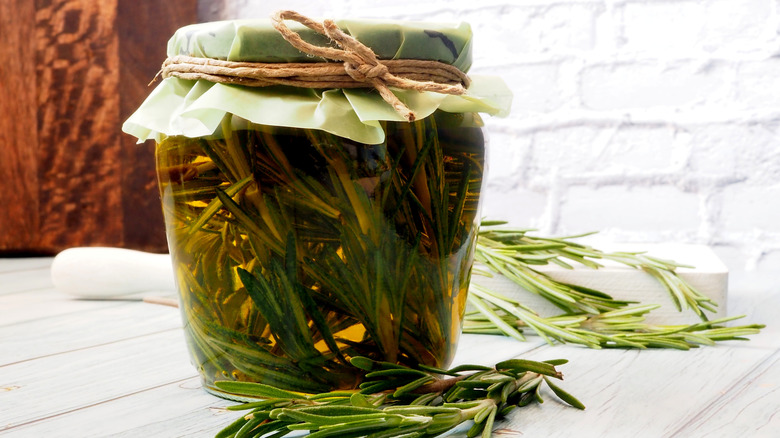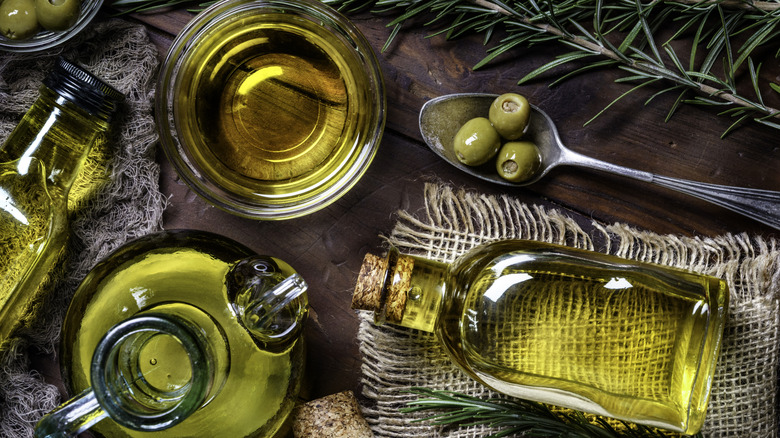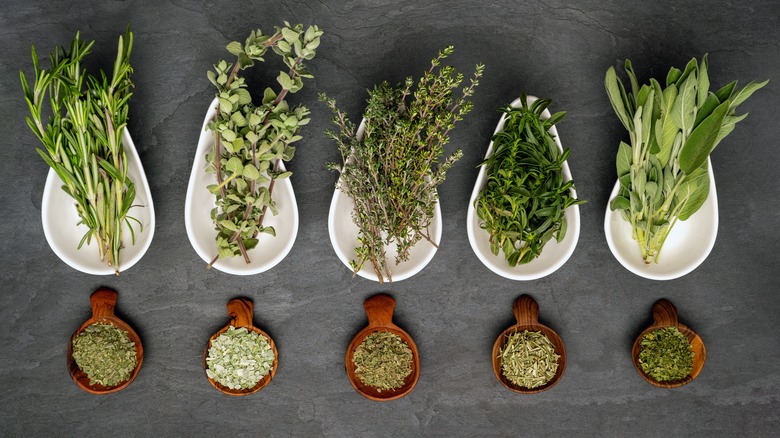The 2 Easy Methods You Can Use To Infuse Olive Oil
If you've ever sampled a deliciously aromatic and herb-forward blend at an olive oil tasting room or restaurant, you'll understand the hype behind infused oils. Whether it's olive oil flavored with orange peel or sun-dried tomatoes, some blends can be absolutely mouthwatering — but that high price tag might just make you hesitate. Luckily, it's so easy to create your own artisanal blends of oil at home that you might just end up turning your kitchen into a miniature apothecary! Different infusions can be used in all sorts of recipes for drizzling, marinading, or cooking. The flavor-packed bottles of olive oil also make great gifts.
The two most common methods of infusing olive oil are the hot method and the cold method. The cold method takes much longer than the hot one — around a week or two versus less than an hour for heated infusions in some cases. But the cold technique can also produce a more potent taste of the infused herbs, and the resulting oil may also have a longer shelf life. The hot method is ready for bottling much more quickly, but may lack the same flavorful impact. There's also the solar method, which is a spin on the cold method that involves long-term infusion with help from the sun, but it's a less widely-used technique. Hot and cold are by far the easiest ways to do it at home.
How to infuse olive oil using hot and cold methods
With both oil infusion methods, you'll likely want to select an oil with a mild taste so as not to overpower the blend — though fuller-flavored extra virgin Italian or Greek olive oils can also work well. For the hot method, you'll need to prepare a double boiler. Place your herbs of choice onto the raised metal bowl and submerge them with the olive oil, stirring frequently. Check that the oil temperature doesn't reach above 140 degrees Fahrenheit. Leave the mixture on the heat for about 20 minutes, remove it, and then allow it to infuse for a few hours before straining it. Then simply pour it into a sanitized glass container.
The cold method is a longer-term commitment. Fill a glass container about halfway with the herbs of your choice, then pour in the olive oil until they're fully submerged. Seal the jar, and store your creation in a cool, dark location for at least 10 days and up to six weeks. Check on it periodically to stir the ingredients, and taste it to see how the flavor is developing. Once the oil has been infused to a level of your liking, strain the herbs using a cheesecloth or strainer, and store the new oil in a clean bottle. In the refrigerator, cold-infused oils can last up to a year, but the shelf life will depend on the ingredients used.
Best practices for infusing fresh and dried ingredients in olive oil
Though infusing olive oil can be relatively simple and fun, you need to take a few precautions to ensure proper food safety. Any fresh herbs should be properly dried so there's no moisture present before being used in an olive oil infusion. This is because water can encourage bacteria to grow. To avoid this risk, it's easiest to either make infused olive oils with pre-dried herbs, or dehydrate fresh herbs yourself in your oven. You can also use the same method to dehydrate garlic, without needing a fancy machine. As a bonus, oils which include dried ingredients have a longer shelf life than with fresh ones. Just always make sure that the bottle or jar you're using to pour the infused oil into is also thoroughly dry, with no water present.
Bacteria which cause botulism won't necessarily affect the taste or the aroma of olive oil, so it's important to maintain safe food practices throughout the entire infusion process. Be aware of other more visible signs that your olive oil has gone bad, too, such as cloudiness, or strange coloration. But don't let this discourage you from the experience of making your own infused olive oil. Just follow proper safety precautions, and let your culinary creativity take the wheel.


